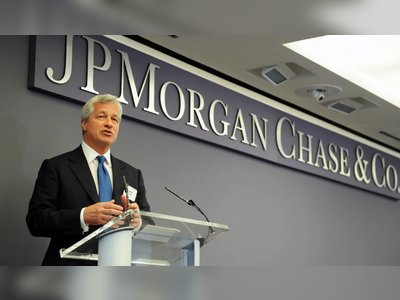Global Economy Faces Uncertainty Amid Resurgent Inflation
Rising prices and supply chain disruptions challenge recovery efforts across major economies.
As countries around the world continue to navigate the economic recovery from the COVID-19 pandemic, recent data indicates a worrying resurgence in inflation that threatens to complicate these efforts.
According to reports, inflation rates have climbed significantly in multiple regions, with consumer prices rising sharply in the United States, Europe, and parts of Asia.
In the United States, the Consumer Price Index (CPI) showed an increase of 8.5% year-on-year in July 2023, driven largely by increased costs in food, energy, and housing.
This marks the highest inflation rate recorded since the early 1980s.
The Federal Reserve has responded by incrementally raising interest rates in an effort to curb inflationary pressures, which has led to heightened borrowing costs for both consumers and businesses.
Meanwhile, in the Eurozone, inflation accelerated to 7.7% in August, as reported by Eurostat.
Energy prices, exacerbated by the ongoing conflict in Ukraine, along with supply chain issues stemming from pandemic-related disruptions, have been major contributors to the price surge.
European Central Bank officials have announced intentions to increase interest rates, aiming to address the inflation crisis.
In Asia, countries such as Japan and South Korea are also feeling the impact of rising prices.
Japan's core inflation rate reached 4.2% in July, its highest in over four decades, prompting the Bank of Japan to reconsider its long-standing monetary easing policies.
South Korea's inflation rate climbed to 6.3%, spurring debates among policymakers about the need for proactive measures to stabilize the economy.
The rising cost of living has led many governments to introduce various measures to assist the most affected populations.
In the UK, for instance, the government announced a £25 billion support package to help households cope with rising energy bills and inflation, aimed at reducing the financial strain on families.
Various sectors are observing significant impacts due to inflation.
The agricultural sector has reported increased costs of production, driven by higher prices for fertilizers, fuel, and shipping.
Similarly, the global semiconductor shortage continues to cause delays in electronics manufacturing, further aggravating inflationary trends.
Global markets have reacted with volatility as investors assess the implications of persistent inflation and the potential for central banks to continue tightening monetary policy.
Stock markets have experienced fluctuations, reflecting concerns over growth prospects as borrowing costs rise.
Trade organizations have highlighted the risk that prolonged inflationary pressures could derail the post-pandemic recovery, noting that if consumers are forced to reduce spending due to higher prices, this could lead to decreased economic activity across multiple sectors.
International monetary bodies call for coordinated responses to manage inflation while ensuring that growth is not stifled.
Experts suggest that addressing supply chain bottlenecks and enhancing production capacities will be critical in mitigating further inflationary pressures and facilitating sustained economic growth across borders.
According to reports, inflation rates have climbed significantly in multiple regions, with consumer prices rising sharply in the United States, Europe, and parts of Asia.
In the United States, the Consumer Price Index (CPI) showed an increase of 8.5% year-on-year in July 2023, driven largely by increased costs in food, energy, and housing.
This marks the highest inflation rate recorded since the early 1980s.
The Federal Reserve has responded by incrementally raising interest rates in an effort to curb inflationary pressures, which has led to heightened borrowing costs for both consumers and businesses.
Meanwhile, in the Eurozone, inflation accelerated to 7.7% in August, as reported by Eurostat.
Energy prices, exacerbated by the ongoing conflict in Ukraine, along with supply chain issues stemming from pandemic-related disruptions, have been major contributors to the price surge.
European Central Bank officials have announced intentions to increase interest rates, aiming to address the inflation crisis.
In Asia, countries such as Japan and South Korea are also feeling the impact of rising prices.
Japan's core inflation rate reached 4.2% in July, its highest in over four decades, prompting the Bank of Japan to reconsider its long-standing monetary easing policies.
South Korea's inflation rate climbed to 6.3%, spurring debates among policymakers about the need for proactive measures to stabilize the economy.
The rising cost of living has led many governments to introduce various measures to assist the most affected populations.
In the UK, for instance, the government announced a £25 billion support package to help households cope with rising energy bills and inflation, aimed at reducing the financial strain on families.
Various sectors are observing significant impacts due to inflation.
The agricultural sector has reported increased costs of production, driven by higher prices for fertilizers, fuel, and shipping.
Similarly, the global semiconductor shortage continues to cause delays in electronics manufacturing, further aggravating inflationary trends.
Global markets have reacted with volatility as investors assess the implications of persistent inflation and the potential for central banks to continue tightening monetary policy.
Stock markets have experienced fluctuations, reflecting concerns over growth prospects as borrowing costs rise.
Trade organizations have highlighted the risk that prolonged inflationary pressures could derail the post-pandemic recovery, noting that if consumers are forced to reduce spending due to higher prices, this could lead to decreased economic activity across multiple sectors.
International monetary bodies call for coordinated responses to manage inflation while ensuring that growth is not stifled.
Experts suggest that addressing supply chain bottlenecks and enhancing production capacities will be critical in mitigating further inflationary pressures and facilitating sustained economic growth across borders.
AI Disclaimer: An advanced artificial intelligence (AI) system generated the content of this page on its own. This innovative technology conducts extensive research from a variety of reliable sources, performs rigorous fact-checking and verification, cleans up and balances biased or manipulated content, and presents a minimal factual summary that is just enough yet essential for you to function as an informed and educated citizen. Please keep in mind, however, that this system is an evolving technology, and as a result, the article may contain accidental inaccuracies or errors. We urge you to help us improve our site by reporting any inaccuracies you find using the "Contact Us" link at the bottom of this page. Your helpful feedback helps us improve our system and deliver more precise content. When you find an article of interest here, please look for the full and extensive coverage of this topic in traditional news sources, as they are written by professional journalists that we try to support, not replace. We appreciate your understanding and assistance.










